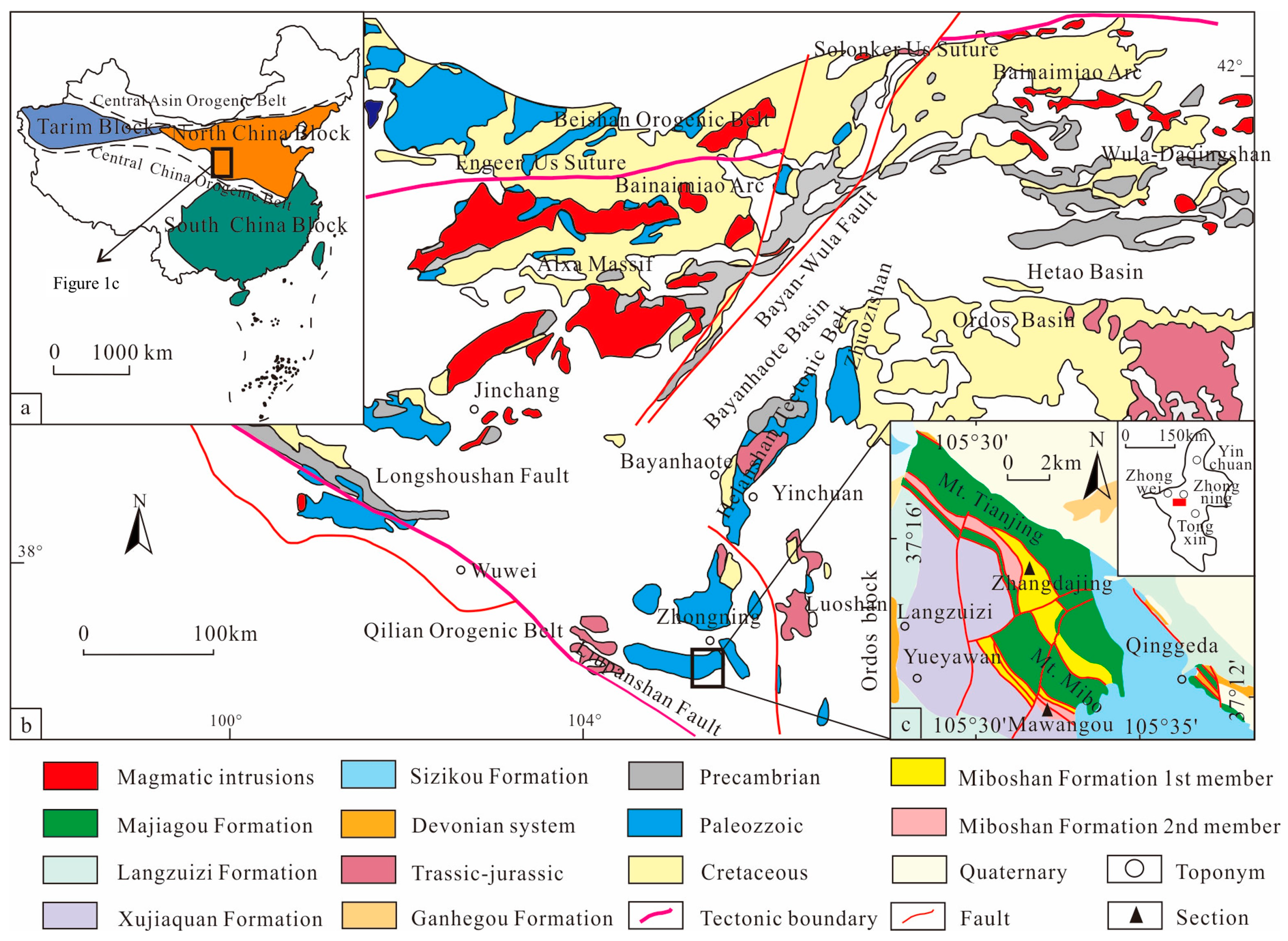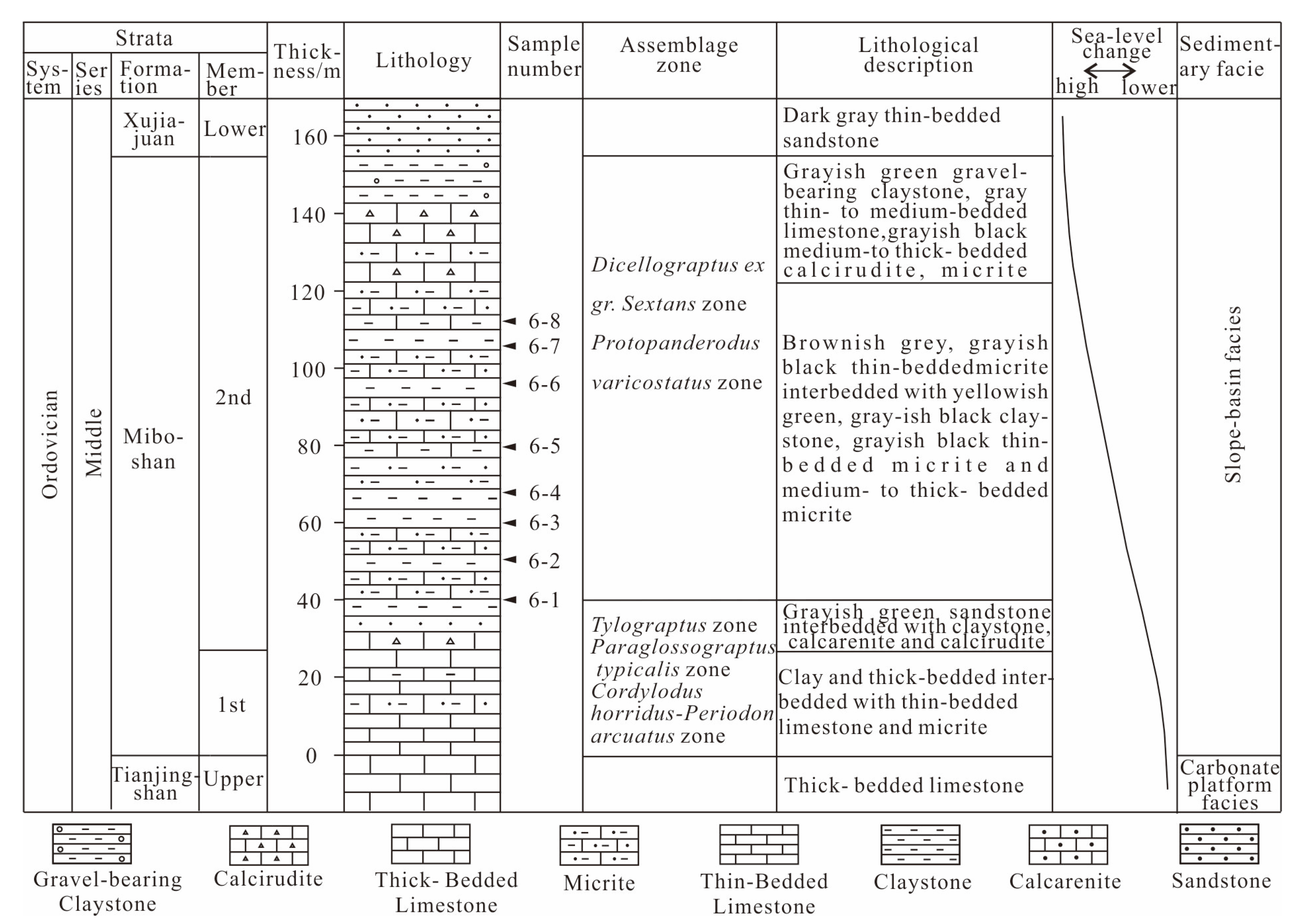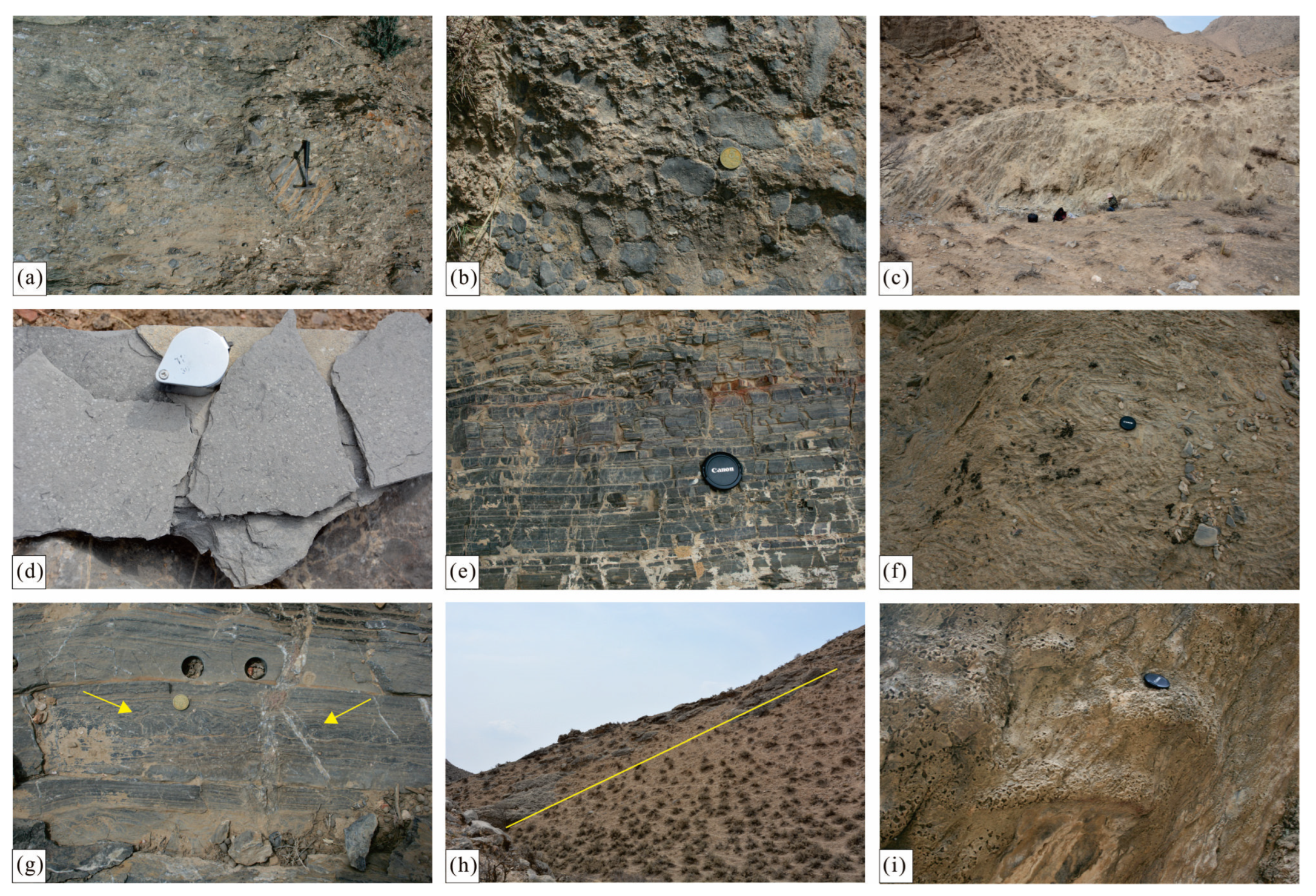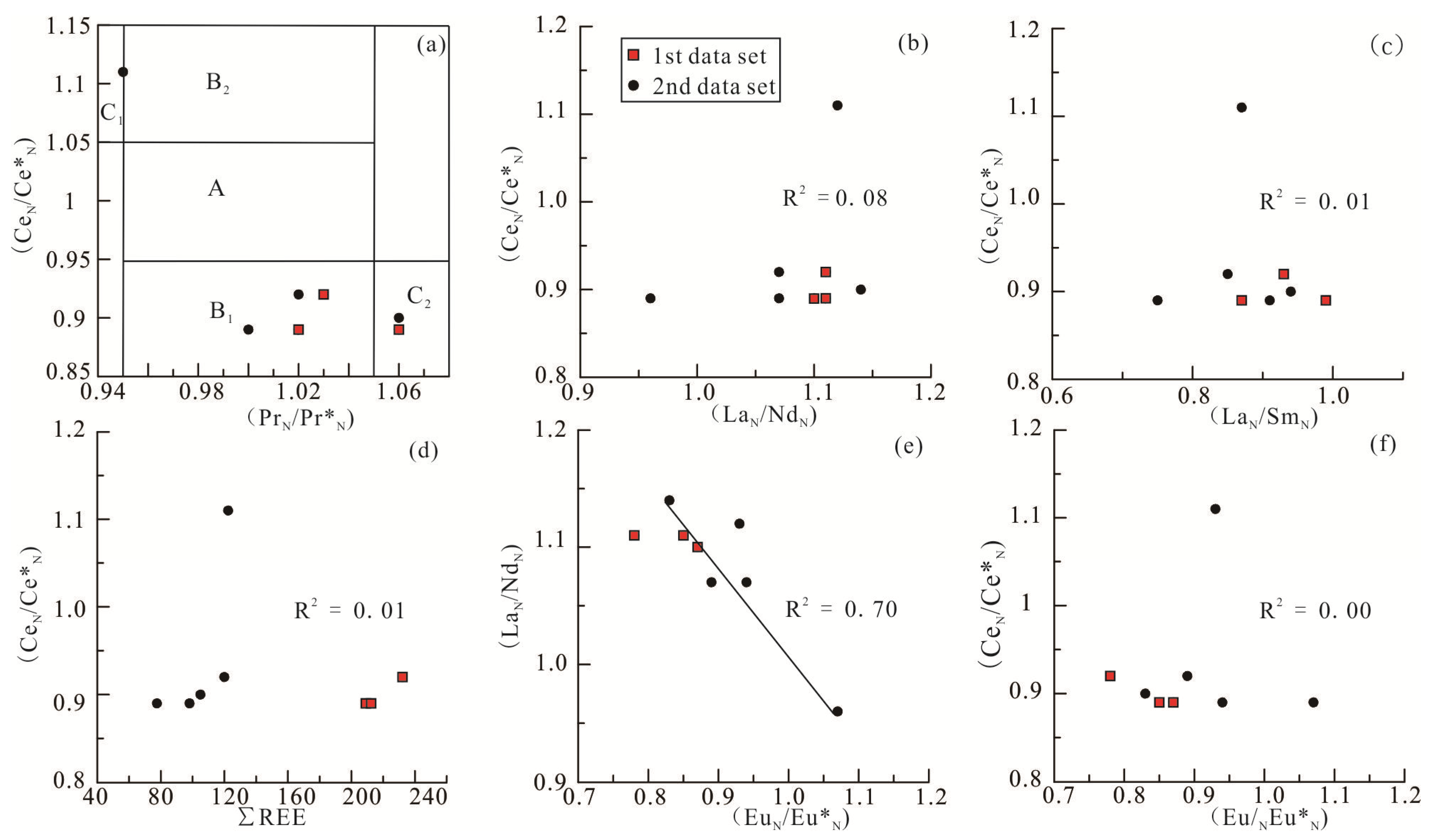Paleoenvironmental Significance of Claystone in the Middle Ordovician Miboshan Formation of Ordos Basin, China: Evidence from Trace Elements
Abstract
:1. Introduction
2. Geological Setting
3. Samples and Methods
4. Results
4.1. Lithologies of Profile
4.2. Geochemical Characteristics
Evaluation of Sample Effectiveness
4.3. REE Characteristics and Distribution Patterns
4.4. Characteristics of Other Elements
5. Discussion
5.1. Depositional Environment and Characteristics of Seawater
5.1.1. Depositional Environment
5.1.2. Seawater Characteristics
5.1.3. Redox Conditions
5.2. Tectonic Environment
5.2.1. Provenance Characteristics
5.2.2. Tectonic Environment Analysis
5.3. Sedimentary Model
6. Conclusions
- (1)
- The Miboshan Formation in the study area deposited in a deep-water environment from slope–basin facies in an extensional back-arc developed in the active continental margin. The seawater depth is ~400 m, and graptolite shale facies, deep-water in situ deposits, and debris flow deposits were developed.
- (2)
- The Miboshan Formation deposited in a small, ponded basin, which was confined by a subaqueous uplift, so that the seawater was greatly affected by fresh water and slightly affected by unstable island arc provenance and the submarine hydrothermal condition.
- (3)
- The lower part of the second member of the Miboshan Formation (first data set) was deposited in a small subaqueous uplift, which was confine-limited such that seawater was relatively less affected by fresh water, and the anoxicity is relatively strong while the provenance is mainly a terrigenous material with a few effects from the volcanic island arc and the submarine hydrothermal condition.
- (4)
- The upper part of the second member of the Miboshan Formation (second data set) was deposited in a significant subaquatic uplift, which was confined well so that seawater was strongly affected by fresh water, the anoxicity is relatively weak, and the provenance is nearly entirely composed of recycled sedimentary rocks.
Author Contributions
Funding
Data Availability Statement
Conflicts of Interest
References
- Guo, Y.R.; Zhao, Z.Y.; Fu, J.H.; Xu, W.L.; Shi, X.Y.; Sun, L.Y.; Gao, J.R.; Zhang, Y.L.; Zhang, Y.Q.; Liu, J.B.; et al. Sequence lithofacies paleogeography of Ordovician in Ordos Basin, China. Acta Pet. Sin. 2012, 33, 95–109. [Google Scholar] [CrossRef]
- Lin, C.S.; Yang, Q.; Li, S.T.; Li, Z. Sedimentary characters of the early Paleozoic deep water gravity flow system and basin filling style of in the helanola trough. Geoscience 1991, 5, 252–262+347. [Google Scholar]
- Gao, Z.Z.; Luo, S.S.; He, Y.B.; Zhang, J.S. Ordovician submarine fan systems in west margin of Ordos. Oil Gas Geol. 1995, 16, 119–125+203. [Google Scholar] [CrossRef]
- Sun, J.; Dong, Y. Ordovician tectonic shift in the western North China Craton constrained by stratigraphic and geochronological analyses. Basin Res. 2020, 32, 1413–1440. [Google Scholar] [CrossRef]
- Li, X.D.; He, Y.B.; Wang, D.; Luo, J.X.; Li, H.; Zheng, Z.C. Internal-wave and internal-tide deposits of the Middle Ordovicaian Xiangshan Group Xujiajuan Formation, Ningxia. J. Palaeogeogr. 2009, 11, 513–523. [Google Scholar]
- Li, X.D.; Chen, H.Y. Paleocurrents direction analysis and identification of clog turbidity current deposits in deep water environment: A case study of the Upper Ordovician Lashizhong Formation in Zhuozishan area, Ordos Basin. Acta Pet. Sin. 2020, 41, 1348–1365. [Google Scholar] [CrossRef]
- Xu, L.M.; Zhou, L.F.; Zhang, Y.K.; Yang, W.J.; Lu, B. Record of deposition magmatism of Xiangshan Group and the reflection of tectonic environment. J. Northwest Univ. 2006, 36, 442–448. [Google Scholar] [CrossRef]
- Xu, S.M.; Feng, H.W.; Li, S.Z.; Li, M. Study on the Caledonian Movement in Helanshan and its surrounding area. Acta Petrol. Sin. 2016, 32, 2137–2150. [Google Scholar]
- Li, X.D.; Wei, Z.Y.; Chen, H.D. Genetic analysis of internal-wave and internal-tide deposits in the Upper Ordovician Lashenzhong Formation, western Ordos basin. Acta Geol. Sin. 2023, 97, 1278–1294. [Google Scholar] [CrossRef]
- Wang, Z.T.; Zhou, H.R.; Wang, J.L.; Jing, X.C. Provenance and tectonic settings analysis of Yingtaogou formation of Middle Ordovician in Helan Mountain area. Acta Sedimentol. Sin. 2014, 32, 205–217. [Google Scholar] [CrossRef]
- Zhang, K. Olistostrome in qrdovician system, western and southern margin of ordos basin. Acta Sedimentol. Sin. 1992, 10, 11–18. [Google Scholar] [CrossRef]
- Liu, X.; You, G.Q. Tectonic zoning of the East China Sea. Geol. China 2015, 42, 1–17. [Google Scholar]
- Zhang, J.; Ma, Z.J.; Ren, W.J.; Lei, Y.L. Structural characterisitics in the Niushoushan Area, Tectonic central Ningxia and its geological significance. Geotecton. Metallog. 2003, 27, 132–142. [Google Scholar] [CrossRef]
- Yang, W.J. Sedimentary Evolution of Ordovician in the Western Margin of Ordos Basin and Its Oi1-Gas Geological Conditions. Ph.D. Thesis, Northwest University, Xi’an, China, 2006; pp. 29–31. [Google Scholar]
- Xie, G.A.; Zhang, Q.L.; Guo, L.Z. The genesis and hydrocarbon distribution of western and southern margins of Paleozoic foreland basin and central paleouplift in Ordos Basin. Acta Pet. Sin. 2003, 24, 18–29. [Google Scholar]
- Li, S.Z.; Li, T.; Zhao, S.j.; Li, X.Y.; Liu, X.; Guo, L.L.; Yu, S.Y.; Li, S.J. Proto-Tethys Ocean in East Asia (V): Attribute of contientnal margin and microcontinental assembly in the west segment of the northern Proto-Tethys Tectonic Domain. Acta Petrol. Sin. 2017, 33, 1633–1652. [Google Scholar]
- Yang, J.Q.; Zhang, J.T.; He, Z.L.; Zhang, T. Paleoenvironment reconstruction of the Middle Ordovician thick carbonate from western Ordos Basin, China. Pet. Sci. 2023, 20, 48–59. [Google Scholar] [CrossRef]
- Huo, F.C. Introduction to Geology of Ningxia; Science Press: Beijing, China, 1989; pp. 43–65. [Google Scholar]
- Gu, Q.C. Petro Stratigraph of Ningxia Hui Autonomous Region; China University of Geosciences Press: Wuhan, China, 1996; pp. 29–42. [Google Scholar]
- Mclennan, S.M. Rare earth elements in sedimentary rocks: Influence of Provenance and sedimentary processes. Rev. Mineral. 1989, 21, 169–200. [Google Scholar]
- Lawrence, M.G.; Greig, A.; Collerson, K.D.; Kamber, B.S. Rare earth element and Yttrium variablility in South East Queensland waterways. Aquat. Geochem. 2006, 12, 39–72. [Google Scholar] [CrossRef]
- Frimmel, H.E. Trace element distribution in Neoproterozoic carbonates as palaeoenvironmental indicator. Chem. Geol. 2009, 258, 338–353. [Google Scholar] [CrossRef]
- Shields, G.; Stille, P. Diagenetic constraints on the use of cerium anomalies as palaeoseawater an isotopic and REE study of Cambrian phosphorites. Chem. Geol. 2001, 175, 29–48. [Google Scholar] [CrossRef]
- Huang, S.H.; Zhang, Z.M.; He, S.Y.; Wang, Z.G. Experimental studies on transportable forms and precipitation conditions for REE in sea water. Geochimica 1981, 4, 398–406. [Google Scholar] [CrossRef]
- Bian, P.; Sha, X.; Ma, L.; He, Z.X.; Wang, J.R.; Zhai, X.W. Discovery and tectonic significance of Kawa ophiolites in the Western Member of North Qilian. J. Lanzhou Univ. Nat. Sci. 2016, 52, 142–144. [Google Scholar] [CrossRef]
- He, J.W.; Xie, Y.; Hou, M.C.; Liu, J.Q.; He, L.; Lu, Y.F. Geochemical characteristic sand geological significance of the Silurian Longmaxi Formation shale in Yanjin area, southwestern Sichuan Basin. J. Palaeogeogr. 2021, 23, 1174–1191. [Google Scholar] [CrossRef]
- Boström, K.; Kraemer, T.; Gartner, S. Provenance and accumulation rates of opaline silica, Al, Ti, Fe, Mn, Cu, Ni and Co in Pacific pelagic sediments. Chem. Geol. 1973, 11, 123–148. [Google Scholar] [CrossRef]
- Mou, B.L. Geochemical Characteristics and Prospecting Potential of Xilaokou Gold Deposit in Shandong Province; Peking University Press: Beijing, China, 1999; pp. 1–210. [Google Scholar]
- Bhatia, M.R. Plate tectonics and geochemical composition of sandstones. J. Geol. 1983, 91, 611–627. [Google Scholar] [CrossRef]
- Breit, G.N.; Wanty, R.B. Vanadium accumulation in carbonaceous rocks: A review of geochemical controls during deposition and diagenesis. Chem. Geol. 1991, 91, 83–97. [Google Scholar] [CrossRef]
- El-Anwar, E.A.; Salman, S.A.; Mousa, D.; Aita, S.K. Geochemical and Mineralogical Evaluation of Black Shale and its Hydrocarbon Potentiality, Southwest Sinai, Egypt. Egypt. J. Chem. 2020, 63, 5055–5070. [Google Scholar] [CrossRef]
- El-Anwar, E.A. Evaluation of the Upper Cretaceous Black Shales: A Case Study from Islam and Hamrawin Phosphate Mines, Qussier Area, Southern Eastern Desert, Egypt. Egypt. J. Chem. 2023, 66, 271–290. [Google Scholar] [CrossRef]
- Wang, Z.T.; Zhou, H.R.; Wang, Q.L.; Jing, X.C.; Zhang, Y.S.; Yuan, L.P.; Shen, Z.J. The Ordovician Basin Prototype in the Northwest Ordos Basin: Constraint from the Ordovician Sedimentary Respond in the Helan—Zhuozi Mountains. Geol. Rev. 2016, 4, 1041–1061. [Google Scholar] [CrossRef]
- Li, X.D.; Huan, Y.Q.; Que, Y. REE geochemistry and analysis of sedimentary aqueous media in lower part of Kelimoli Formation, Middle Ordovician, Zhuozishan area. Chin. J. Geol. 2018, 52, 547–565. [Google Scholar] [CrossRef]
- Li, X.D.; He, Y.B. Geochemical characteristics and age significance of limestone in the Top of Xujiaquan Formation of Xiangshan Group, Ningxia. Geochemistry 2019, 48, 325–341. [Google Scholar] [CrossRef]
- Alibo, D.S.; Nozaki, Y. Rare earth elements in seawater: Particle association, shale normalization, and Ceoxidation. Geochim. Cosmochim. Acta 1999, 63, 363–372. [Google Scholar] [CrossRef]
- Zheng, R.C.; Liu, M.Q. Study on paleosalinity of Chang-6 oil reservoir set in Ordos Basin. Oil Gas Geol. 1999, 20, 22–27. [Google Scholar] [CrossRef]
- Li, X.D.; He, Y.B. REE geochemistry and their indicators of sedimentary aqueous media at the top of Xujiajuan Formation, Xiangshan Group in Ningxia Autonomous Region, China. J. Jilin Univ. 2020, 50, 139–157. [Google Scholar]
- Byrne, R.H.; Sholkovitz, E.R. Marine chemistry and geochemistry of the lanthanides. Handb. Phys. Chem. Rare Earths 1996, 23, 497–593. [Google Scholar] [CrossRef]
- Elderfield, H.; Greaves, M.J. The Rare Earth Elements in Seawater. Nature 1982, 296, 214–219. [Google Scholar] [CrossRef]
- Jones, B.; Manning, D.A.C. Comparison of geochemical indices used for the interpretation of depositional environments in ancient mudstones. Chem. Geol. 1994, 111, 112–129. [Google Scholar] [CrossRef]
- Lin, Z.J.; Chen, D.F.; Liu, Q. Geochemical indices for redox conditions of marine sediments. Bull. Mineral. Petrol. Geochem. 2008, 27, 72–80. [Google Scholar] [CrossRef]
- Song, G.; Miao, Z.Y.; Du, S.R.; Li, X.M. Geochemical characteristics of trace elements before and after the upper salt forming period of the mk-3 core, simao basin and their paleoenvironmental implications. Acta Geosci. Sin. 2022, 43, 584–592. [Google Scholar] [CrossRef]
- Yan, M.C.; Chi, Q.H. The Chemical Compositions of the Continental and Rocks in the Eastern Part of China; Science Press: Beijing, China, 1997; pp. 180–192. ISBN 7030146670. [Google Scholar]
- Zhang, Y.D.; Zhan, R.B.; Zhen, Y.Y.; Wang, Z.H.; Yuan, W.W.; Fang, X. Ordovician integrative stratigraphy and timescale of China. Sci. China Earth Sci. 2019, 49, 66–92. [Google Scholar] [CrossRef]
- Xia, L.Q.; Xia, Z.C.; Xu, X.Y. Magmagenesis of Ordovician back-arc Basins in the Northern Qilian Mountains. Geol. China 2003, 30, 48–60. [Google Scholar] [CrossRef]
- He, D.F.; Shao, D.B.; Cui, Y.P.; Bao, H.P.; Kai, B.Z.; Fu, D.W.; Cao, Y.G. Delineation, formation, and geological significance of Majatan paleo-uplift at the western margin of Ordos Basin. Acta Pet. Sin. 2018, 39, 609–619. [Google Scholar] [CrossRef]
- Guo, Y.; Li, Y.S.; Ling, Y.; Zhang, H.G.; Hou, Y.J. The sedimentary geochemical characteristics and metallogenic mechanism of manganese-bearing rock series in southeastern Chongqing, China. Acta Geol. Sin. 2018, 92, 2331–2348. [Google Scholar]
- Xie, R.C.; Zhou, W.; Zhang, C.; Lei, T.; Yin, S. Characteristics, influencing factors, and prediction of fractures in weathered crust karst reservoirs: A case study of Ordovician Majiagou Formation in the Daniudi Gas Field, Ordos Basin, China. Geol. J. 2020, 55, 7790–7806. [Google Scholar] [CrossRef]
- Li, W.J.; Chen, J.T.; Hakim, A.J.; Myrow, P.M. Middle Ordovician mass-transport deposits from western Inner Mongolia, China: Mechanisms and implications for basin evolution. Sedimentology 2021, 69, 1301–1338. [Google Scholar] [CrossRef]







| Sample Number | 6-1 | 6-2 | 6-3 | 6-4 | 6-5 | 1st Data Set | 6-6 | 6-7 | 6-8 | 2nd Data Set | Average |
|---|---|---|---|---|---|---|---|---|---|---|---|
| La | 26.20 | 23.60 | 24.80 | 20.50 | 17.30 | 22.48 | 51.70 | 49.00 | 46.60 | 49.10 | 31.35 |
| Ce | 48.30 | 42.70 | 55.40 | 37.40 | 30.60 | 42.88 | 95.80 | 86.40 | 83.30 | 88.50 | 58.09 |
| Pr | 5.64 | 5.05 | 5.35 | 4.57 | 3.63 | 4.85 | 11.05 | 10.10 | 10.10 | 10.42 | 6.70 |
| Nd | 21.80 | 18.30 | 19.70 | 19.00 | 14.30 | 18.62 | 41.50 | 39.40 | 37.40 | 39.43 | 25.56 |
| Sm | 4.48 | 3.66 | 4.14 | 3.98 | 2.75 | 3.80 | 8.07 | 7.22 | 7.80 | 7.70 | 5.10 |
| Eu | 0.77 | 0.60 | 0.77 | 0.86 | 0.51 | 0.70 | 1.19 | 1.12 | 1.28 | 1.20 | 0.87 |
| Gd | 3.74 | 3.17 | 3.69 | 3.60 | 2.36 | 3.31 | 6.44 | 5.02 | 6.52 | 5.99 | 4.21 |
| Tb | 0.61 | 0.52 | 0.58 | 0.59 | 0.40 | 0.54 | 1.06 | 0.85 | 1.08 | 1.00 | 0.69 |
| Dy | 3.44 | 2.87 | 3.07 | 3.17 | 2.10 | 2.93 | 6.11 | 4.67 | 5.81 | 5.53 | 3.80 |
| Ho | 0.70 | 0.61 | 0.64 | 0.67 | 0.46 | 0.62 | 1.29 | 1.13 | 1.25 | 1.22 | 0.82 |
| Er | 1.78 | 1.64 | 1.87 | 1.61 | 1.41 | 1.66 | 3.42 | 3.20 | 3.35 | 3.32 | 2.22 |
| Tm | 0.31 | 0.23 | 0.30 | 0.25 | 0.17 | 0.25 | 0.60 | 0.48 | 0.51 | 0.53 | 0.34 |
| Yb | 1.93 | 1.71 | 1.81 | 1.63 | 1.36 | 1.69 | 3.39 | 3.33 | 3.50 | 3.41 | 2.26 |
| Lu | 0.27 | 0.26 | 0.26 | 0.23 | 0.18 | 0.24 | 0.55 | 0.52 | 0.54 | 0.54 | 0.34 |
| Y | 18.60 | 16.70 | 17.90 | 17.90 | 12.80 | 16.78 | 34.30 | 28.10 | 32.70 | 31.70 | 21.75 |
| ∑REE | 119.97 | 104.92 | 122.38 | 98.06 | 77.53 | 104.57 | 232.17 | 212.44 | 209.04 | 217.88 | 142.34 |
| ∑REE + Y | 138.57 | 121.62 | 140.28 | 115.96 | 90.33 | 121.35 | 266.47 | 240.54 | 241.74 | 249.58 | 164.10 |
| LREE | 107.19 | 93.91 | 110.16 | 86.31 | 69.09 | 93.33 | 209.31 | 193.24 | 186.48 | 196.34 | 127.67 |
| HREE | 12.78 | 11.01 | 12.22 | 11.75 | 8.44 | 11.24 | 22.86 | 19.20 | 22.56 | 21.54 | 14.67 |
| L/H | 8.39 | 8.53 | 9.01 | 7.35 | 8.19 | 8.29 | 9.16 | 10.06 | 8.27 | 9.16 | 8.58 |
| La/Nd | 1.20 | 1.29 | 1.26 | 1.08 | 1.21 | 1.21 | 1.25 | 1.24 | 1.25 | 1.25 | 1.22 |
| La/Ce | 0.54 | 0.55 | 0.45 | 0.55 | 0.57 | 0.53 | 0.54 | 0.57 | 0.56 | 0.56 | 0.54 |
| CeN/Ce*N | 0.92 | 0.90 | 1.11 | 0.89 | 0.89 | 0.94 | 0.92 | 0.89 | 0.89 | 0.90 | 0.93 |
| PrN/Pr*N | 1.02 | 1.06 | 0.95 | 1.00 | 1.02 | 1.01 | 1.03 | 1.02 | 1.06 | 1.04 | 1.02 |
| EuN/Eu*N | 0.89 | 0.83 | 0.93 | 1.07 | 0.94 | 0.93 | 0.78 | 0.87 | 0.85 | 0.83 | 0.90 |
| LaN/La*N | 1.09 | 0.97 | 0.99 | 1.24 | 1.16 | 1.09 | 1.04 | 1.16 | 1.00 | 1.07 | 1.08 |
| LaN/YbN | 1.00 | 1.02 | 1.01 | 0.93 | 0.94 | 0.98 | 1.13 | 1.09 | 0.98 | 1.07 | 1.01 |
| LaN/NdN | 1.07 | 1.14 | 1.12 | 0.96 | 1.07 | 1.07 | 1.11 | 1.10 | 1.11 | 1.11 | 1.08 |
| LaN/SmN | 0.85 | 0.94 | 0.87 | 0.75 | 0.91 | 0.86 | 0.93 | 0.99 | 0.87 | 0.93 | 0.89 |
| Al2O3 | 10.84 | 10.99 | 10.78 | 7.62 | 7.84 | 9.61 | 19.26 | 20.81 | 19.27 | 19.78 | 13.00 |
| CaO | 23.50 | 22.90 | 22.90 | 31.00 | 30.40 | 26.14 | 0.51 | 0.37 | 0.22 | 0.37 | 17.55 |
| TFe2O3 | 4.53 | 4.51 | 4.64 | 3.51 | 3.28 | 4.09 | 7.72 | 7.25 | 7.53 | 7.50 | 5.23 |
| MgO | 2.99 | 2.96 | 3.09 | 2.44 | 3.74 | 3.04 | 2.82 | 2.95 | 2.59 | 2.79 | 2.96 |
| SiO2 | 31.52 | 32.03 | 32.49 | 24.61 | 22.60 | 28.65 | 58.69 | 57.69 | 59.61 | 58.66 | 38.65 |
| FeO | 3.03 | 3.04 | 3.16 | 2.40 | 2.28 | 2.78 | 5.21 | 4.79 | 4.94 | 4.98 | 3.51 |
| SiO2/Al2O3 | 2.91 | 2.91 | 3.01 | 3.23 | 2.88 | 2.99 | 3.05 | 2.77 | 3.09 | 2.97 | 2.98 |
| Fe3+/Fe2+ | 0.45 | 0.44 | 0.42 | 0.42 | 0.39 | 0.42 | 0.43 | 0.46 | 0.66 | 0.52 | 0.46 |
| Fe2O3 | 3.17 | 3.16 | 3.25 | 2.46 | 2.30 | 2.87 | 5.40 | 5.08 | 5.27 | 5.25 | 3.66 |
| Ba | 259.00 | 242.00 | 254.00 | 175.00 | 192.50 | 224.50 | 477.00 | 510.00 | 506.00 | 497.67 | 315.56 |
| Cr | 60.00 | 60.00 | 60.00 | 40.00 | 50.00 | 54.00 | 110.0 | 110.0 | 100.0 | 106.6 | 71.56 |
| Rb | 125.00 | 116.50 | 121.50 | 83.80 | 93.70 | 108.10 | 238.00 | 255.00 | 230.00 | 241.00 | 152.40 |
| Sr | 336.00 | 337.00 | 322.00 | 484.00 | 499.00 | 395.60 | 63.30 | 84.70 | 67.50 | 71.83 | 287.68 |
| Th | 10.65 | 9.52 | 10.60 | 8.34 | 6.96 | 9.21 | 22.20 | 21.20 | 20.40 | 21.27 | 13.23 |
| U | 2.34 | 2.16 | 2.09 | 1.92 | 1.88 | 2.08 | 3.72 | 3.40 | 3.33 | 3.48 | 2.55 |
| V | 78.00 | 70.00 | 76.00 | 54.00 | 57.00 | 67.00 | 138.00 | 149.00 | 126.00 | 137.67 | 90.56 |
| Zr | 100.00 | 89.00 | 103.00 | 71.00 | 64.00 | 85.40 | 195.00 | 181.00 | 175.00 | 183.67 | 118.16 |
| Sr/Ba | 1.30 | 1.39 | 1.27 | 2.77 | 2.59 | 1.86 | 0.13 | 0.17 | 0.13 | 0.14 | 1.29 |
| V/Cr | 1.30 | 1.17 | 1.27 | 1.35 | 1.14 | 1.25 | 1.25 | 1.35 | 1.26 | 1.29 | 1.26 |
| U/Th | 0.22 | 0.23 | 0.20 | 0.23 | 0.27 | 0.23 | 0.17 | 0.16 | 0.16 | 0.16 | 0.21 |
| Zr/Rb | 0.80 | 0.76 | 0.85 | 0.85 | 0.68 | 0.79 | 0.82 | 0.71 | 0.76 | 0.76 | 0.78 |
| Th/U | 4.55 | 4.41 | 5.07 | 4.34 | 3.70 | 4.41 | 5.97 | 6.24 | 6.13 | 6.11 | 4.98 |
| Indicators | The Average | Result | Standard of Indicators | ||||
|---|---|---|---|---|---|---|---|
| 1st | 2nd | total | 1st | 2nd | Total | ||
| Ce anomaly | 0.94 | 0.90 | 0.93 | weaker anoxicity | stronger anoxicity | anoxic condition | Negative Ce anomalies in abiotic rocks indicates anoxic condition [39] |
| Ceanom | 0.03 | 0.05 | 0.04 | stronger anoxicity | weaker anoxicity | anoxic condition | Ceanom > −0.1 indicates anoxic condition; Ceanom < −0.1 indicates oxic condition [40] |
| Ce/La | 1.90 | 1.80 | 1.86 | stronger anoxicity | weaker anoxicity | weak anoxic condition | 1.5 ≤ Ce/La < 1.8 indicates oxygen-poor environment, 1.8 ≤ Ce/La < 2 indicates weak anoxic condition, and Ce/La ≥ 2 indicates anoxic condition [40] |
| V/Cr | 1.24 | 1.29 | 1.26 | oxic condition | oxic condition | oxic condition | V/Cr > 4.25 indicates anoxic condition [41]; V/Cr < 1.2 indicates oxic condition; V/Cr>1.2 indicates dysoxic condition [26] |
| Fe3+/Fe2+ | 0.42 | 0.52 | 0.46 | stronger anoxicity | weaker anoxicity | anoxic condition | Fe3+/Fe2+ < 1 indicates anoxic condition; Fe3+/Fe2+ > 1 indicates oxic condition |
Disclaimer/Publisher’s Note: The statements, opinions and data contained in all publications are solely those of the individual author(s) and contributor(s) and not of MDPI and/or the editor(s). MDPI and/or the editor(s) disclaim responsibility for any injury to people or property resulting from any ideas, methods, instructions or products referred to in the content. |
© 2023 by the authors. Licensee MDPI, Basel, Switzerland. This article is an open access article distributed under the terms and conditions of the Creative Commons Attribution (CC BY) license (https://creativecommons.org/licenses/by/4.0/).
Share and Cite
Wei, Z.; Li, X. Paleoenvironmental Significance of Claystone in the Middle Ordovician Miboshan Formation of Ordos Basin, China: Evidence from Trace Elements. Minerals 2023, 13, 1383. https://doi.org/10.3390/min13111383
Wei Z, Li X. Paleoenvironmental Significance of Claystone in the Middle Ordovician Miboshan Formation of Ordos Basin, China: Evidence from Trace Elements. Minerals. 2023; 13(11):1383. https://doi.org/10.3390/min13111383
Chicago/Turabian StyleWei, Zeyi, and Xiangdong Li. 2023. "Paleoenvironmental Significance of Claystone in the Middle Ordovician Miboshan Formation of Ordos Basin, China: Evidence from Trace Elements" Minerals 13, no. 11: 1383. https://doi.org/10.3390/min13111383
APA StyleWei, Z., & Li, X. (2023). Paleoenvironmental Significance of Claystone in the Middle Ordovician Miboshan Formation of Ordos Basin, China: Evidence from Trace Elements. Minerals, 13(11), 1383. https://doi.org/10.3390/min13111383






